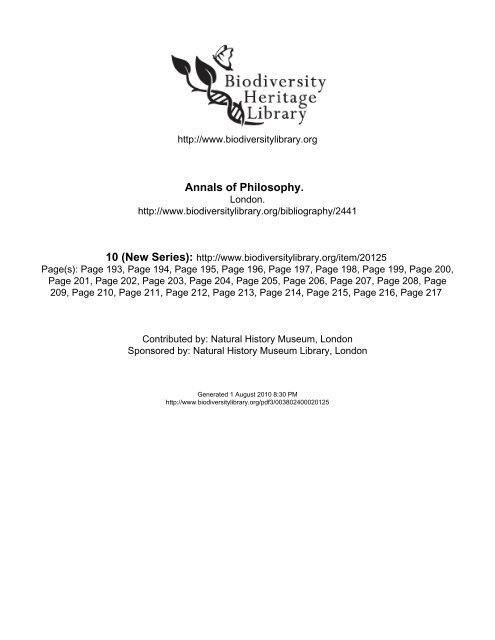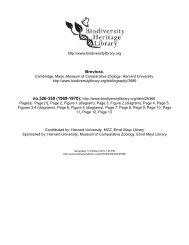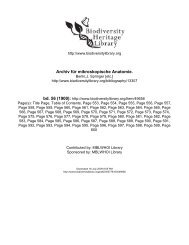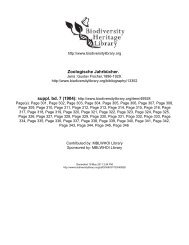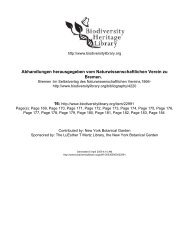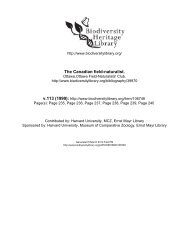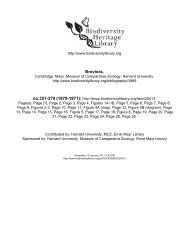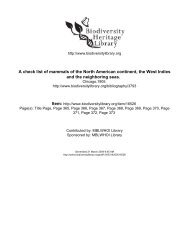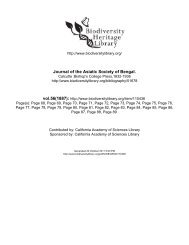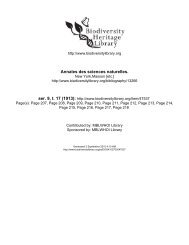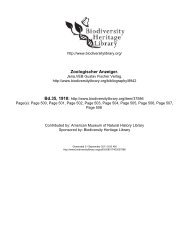A synopsis of the genera of reptiles and Amphibia, with a description ...
A synopsis of the genera of reptiles and Amphibia, with a description ...
A synopsis of the genera of reptiles and Amphibia, with a description ...
Create successful ePaper yourself
Turn your PDF publications into a flip-book with our unique Google optimized e-Paper software.
http://www.biodiversitylibrary.org<br />
Annals <strong>of</strong> Philosophy.<br />
London.<br />
http://www.biodiversitylibrary.org/bibliography/2441<br />
10 (New Series): http://www.biodiversitylibrary.org/item/20125<br />
Page(s): Page 193, Page 194, Page 195, Page 196, Page 197, Page 198, Page 199, Page 200,<br />
Page 201, Page 202, Page 203, Page 204, Page 205, Page 206, Page 207, Page 208, Page<br />
209, Page 210, Page 211, Page 212, Page 213, Page 214, Page 215, Page 216, Page 217<br />
Contributed by: Natural History Museum, London<br />
Sponsored by: Natural History Museum Library, London<br />
Generated 1 August 2010 8:30 PM<br />
http://www.biodiversitylibrary.org/pdf3/003802400020125
This page intentionally left blank.
The following text is <strong>genera</strong>ted from uncorrected OCR.<br />
[Begin Page: Page 193]<br />
1 825.] Mr. Gray on <strong>the</strong> Genera <strong>of</strong> Reptiles, 193<br />
<strong>of</strong> carbon, as Mr. Br<strong>and</strong>e conjectures, or, what is perhaps more<br />
likely, as a gaseous compound, containing a less proportion <strong>of</strong><br />
sulphur than exists in that liquid.<br />
- 'In whatever state <strong>of</strong> combination <strong>the</strong> sulphur may be, it does<br />
not affect <strong>the</strong> salts <strong>of</strong> lead like sulphuretted hydrogen ; nor does<br />
it act so readily, if at all, on polished silver <strong>and</strong> gold. Hence<br />
<strong>the</strong> gas which contains only this impurity, will be less injurious,<br />
when any <strong>of</strong> it escapes unburnt, than such as contains sulphur-<br />
etted hydrogen ; but since it uniformly yields acid vapours<br />
during its combustidn, '§flfe pisirt <strong>of</strong> <strong>the</strong>f objection remains in full<br />
f^rce. -u-MiH'io nm t^^.-> . . : - ..- ^ '<br />
• 'These various objections, whatever wfeight <strong>the</strong>y may have,<br />
jigply to coal gas only. ^ y<br />
' -D'sq.gj 'iUi'k) ja jihjin'i ji^ij a j>;i^H# , „^ , nf>ffy i ^- aimu-j ni ' Jj;>U^.<br />
j'5M| h huU j:>una?H'y'^loil* f l>i.%b' ''vlbTB^FA^ ip^»lto 4di \,W^igii<br />
A Si/nopsis <strong>of</strong> <strong>the</strong> Genera <strong>of</strong> Reptiles <strong>and</strong> <strong>Amphibia</strong>, imlh a<br />
Description <strong>of</strong> spmeneiv Species f By. John Edward Gray, Esq.<br />
'-FGS. &c, ^i ,.imiwimf 'eqi^r)^^ M V
(To <strong>the</strong> Editors <strong>of</strong> <strong>the</strong> Annals <strong>of</strong> Fhilosophy.) jf^lp^'<br />
GENTLEMEN, ^ British Museum, July U, 1825.<br />
The <strong>reptiles</strong> have 'beeri comparatively neglected by recent<br />
zoologists, perhaps on account <strong>of</strong> <strong>the</strong> popular prejudices against<br />
this interesting <strong>and</strong> curious class <strong>of</strong> animals which Linneeus<br />
designates " Animalia pessima tetra nuda." It is only necessary<br />
to overcome <strong>the</strong>se prejudices, <strong>and</strong> to examine <strong>the</strong>m even<br />
superficially, <strong>and</strong> we cannot but be struck <strong>with</strong> <strong>the</strong> beauty <strong>of</strong><br />
<strong>the</strong>ir colours, <strong>the</strong> wonderful nature <strong>of</strong> <strong>the</strong>ir structure, <strong>and</strong> <strong>the</strong><br />
pecuHarities <strong>of</strong> <strong>the</strong>ir habits <strong>and</strong> manners. Indeed I do not<br />
know any class <strong>of</strong> animals better calculated to excite <strong>the</strong> wonder<br />
<strong>and</strong> astonishment <strong>of</strong> a student <strong>of</strong> nature.<br />
With <strong>the</strong> hopes <strong>of</strong> inducing some inquiry into, <strong>and</strong> exd;-<br />
mination <strong>of</strong>, this department <strong>of</strong> natural history, I have<br />
attempted to bring toge<strong>the</strong>r into <strong>the</strong> form <strong>of</strong> a <strong>synopsis</strong>, <strong>the</strong><br />
labour <strong>of</strong> <strong>the</strong> preceding writers on this class, <strong>and</strong> have also<br />
thrown into it my own notes formed on an examination <strong>of</strong> <strong>the</strong><br />
specimens at present under arrangement in <strong>the</strong> British Museum,<br />
which are exceedingly interesting to me in several points o^<br />
view, first, as containing several undescribed species, <strong>and</strong> sp6^<br />
ci'mens <strong>of</strong> interesting or obscure <strong>genera</strong>; <strong>and</strong> secondly, <strong>the</strong><br />
old^r specimens having been examined, <strong>and</strong> most carefully<br />
named by my late uncle, who paid great attention to this<br />
department <strong>of</strong> zoology, <strong>and</strong> several <strong>of</strong> whose manuscript species
still remain unpublished. ^ '•' ' . . : •: i<br />
I need not dwell on <strong>the</strong> distinctness <strong>of</strong> <strong>the</strong> two classes<strong>of</strong> rep-<br />
"iiem Series J vol, x. o<br />
[Begin Page: Page 194]<br />
194 Afr. Gta}f on <strong>the</strong> Genera <strong>of</strong> Reptiles^ [SEPt.<br />
tiles <strong>and</strong> amphibia, or <strong>of</strong> <strong>the</strong> scaly <strong>and</strong> naked-skinned groups, as<br />
<strong>the</strong>y are allowed to be perfectly distinct l)y all modern naturalists,<br />
although <strong>the</strong>y do not agree <strong>with</strong> regard to <strong>the</strong> rank <strong>of</strong> <strong>the</strong> latter<br />
group. I ara inclined to follow <strong>the</strong> opinion <strong>of</strong> Macleay, Blain-<br />
ville, <strong>and</strong> o<strong>the</strong>rs, in considering <strong>the</strong>m both as classes, <strong>and</strong> con*<br />
sequently <strong>of</strong> equal rank.<br />
Class III.— Rettilia.<br />
Body covered <strong>with</strong> scales or hard plates imbedded in <strong>the</strong> skin ;<br />
heart <strong>with</strong> two auricles <strong>and</strong> one ventricle respiring by lungs.<br />
The blood is cold ; <strong>the</strong> windpipe ringed ; <strong>the</strong> ribs are perfect,<br />
jind <strong>the</strong>re are several vertebr» ; <strong>the</strong> penis is distinct, sometimes<br />
double. The e^g is covered <strong>with</strong> a shell, mostly hatched in <strong>the</strong><br />
body <strong>of</strong> <strong>the</strong> mo<strong>the</strong>r.<br />
Synopsis <strong>of</strong> <strong>the</strong> Orders.
Bodi/ covered <strong>with</strong> imbedded hard plates; legs distinct.<br />
Ears closed <strong>with</strong> a valve Emydosauri,<br />
Ears naked, valveless SaurJ.<br />
Body covered toith scales, or tico large shields.<br />
Legs 2-4 weak ; ears naked SacRophidii.<br />
LegsO; earsO Ophidii.<br />
Legs 4 ; body covered <strong>with</strong> two shields. . . Chelonii,<br />
Mr, Macleay, in his excellent Horcd Entomologies, has<br />
observed that <strong>the</strong> order <strong>of</strong> this class appears to assume a circu-<br />
lar disposition ; <strong>the</strong> most visible break m this arrangement is in<br />
<strong>the</strong> passage between <strong>the</strong> snakes <strong>and</strong> <strong>the</strong> tortoises ; for <strong>the</strong> con-<br />
nexion between <strong>the</strong> latter order <strong>and</strong> <strong>the</strong> crocodiles must be visi-<br />
ble to every one, if <strong>the</strong>y only consult Shaw's figure <strong>of</strong> <strong>the</strong><br />
Testudo serpentina, <strong>and</strong> compare it <strong>with</strong> that <strong>of</strong> <strong>the</strong> crocodile, for<br />
it is in fact a crocodile <strong>with</strong> a shortened body, covered <strong>with</strong><br />
united instead <strong>of</strong> distinct shields, <strong>and</strong> a bird's beak. The pas-<br />
sage from <strong>the</strong> crocodiles to <strong>the</strong> lizards by means oiihQMinitors,<br />
has long been known to naturalists, who have <strong>of</strong>ten considered<br />
<strong>the</strong> latter as species <strong>of</strong> <strong>the</strong> former genus ; <strong>and</strong> even Linnaeus<br />
placed <strong>the</strong>m in <strong>the</strong> same section <strong>of</strong> his genus Lacerta. The<br />
Sines have always been placed in <strong>the</strong> same genus or group <strong>with</strong><br />
<strong>the</strong> lizards ; but <strong>the</strong>ir affinity <strong>with</strong> <strong>the</strong> slow-worms did not escape
<strong>the</strong> penetrating eye <strong>of</strong> Linnaeus, who observes that <strong>the</strong> Lacerta<br />
Chalcides, is " Media inter Lacertas et Angues;" <strong>and</strong> <strong>the</strong> union<br />
<strong>of</strong> <strong>the</strong> <strong>genera</strong> Sincus, Anguis, <strong>and</strong> Amphisbena, into an order,<br />
although it has not been done by any zoologist that I am<br />
aware <strong>of</strong>, appears to be strictly natural, for <strong>the</strong> feet in this order<br />
exist in such various degrees <strong>of</strong> developement, that <strong>the</strong><br />
being <strong>with</strong> or <strong>with</strong>out <strong>the</strong>m appears to be only a family<br />
or generic character, <strong>and</strong> not ordinal. Linnaeus placed <strong>the</strong><br />
<strong>genera</strong> Tortrix <strong>and</strong> Eryx <strong>of</strong> <strong>the</strong> true serpents as species <strong>of</strong> his<br />
[Begin Page: Page 195]<br />
1835.] Mr, Gray on <strong>the</strong> Genera <strong>of</strong> Reptiles i \%^<br />
genus Anguis, thus showing that he considered <strong>the</strong>m as nearly<br />
allied. So far <strong>the</strong> passage from one order to <strong>the</strong> o<strong>the</strong>r has<br />
been very easy <strong>and</strong> gradual ; <strong>and</strong> indeed sometimes I have been<br />
doubtful, as in <strong>the</strong> last case, to which order I should refer<br />
<strong>the</strong> <strong>genera</strong>. There is every reason to believe from <strong>genera</strong>l<br />
structure, that <strong>the</strong>re exists an affinity between <strong>the</strong> tortoises <strong>and</strong><br />
<strong>the</strong> snakes, but <strong>the</strong> genus that exactly unites <strong>the</strong>m is at pre-<br />
sent unknown to European naturalists, which is not astonishing<br />
when we consider <strong>the</strong> immense number <strong>of</strong> undescribed animals<br />
which are daily occurring.<br />
Mr. Macleay thought <strong>the</strong>se tw^o orders might be united<br />
by means <strong>of</strong> Emi/s Longicollis (<strong>the</strong> long-necked tortoise) <strong>of</strong>
Shaw ; but <strong>the</strong> family to which this animal belongs appears to<br />
be <strong>the</strong> one which unites this class to <strong>the</strong> crocodile : if I may be al-<br />
lowed to speculate from <strong>the</strong> pecuharities <strong>of</strong> structure which I have<br />
observed, I am inclined to think that <strong>the</strong> union will most proba-<br />
bly take place, by some newly discovered <strong>genera</strong>, allied to <strong>the</strong><br />
marine or fluviatile s<strong>of</strong>t-skinned turtles, <strong>and</strong> <strong>the</strong> marine serpejit.<br />
§ 1. Body covered <strong>with</strong> imbedded hard plates ; legs distinct, fit<br />
fox walking, Loricata, Gray; not Merrem,<br />
,,_. Order I. Emydosauri, Blainv. -<br />
f" Ears closed by two longitudinal valves ; anus longitudinal ^<br />
body covered <strong>with</strong> large imbedded plates ; tongue short adnate ;<br />
legs four ; toes four before, five behind ; sternum long ; clavi-<br />
cles none ; lungs not extended to <strong>the</strong> abdomen j living in or near<br />
water.<br />
Fam, I. Crocodilid^. •<br />
Feet three clawed; hinder ones ; palmate or semi palmate r<br />
tail compressed. k<br />
1. Ali GATOR, Cuv. ^<br />
Head blunt; hind feet semi-palmate. America, -^<br />
A. lucius, Gray. Crocodilus lucius, C2^v. i
2. Crocodilus, Cuv, Champse, Merrem.<br />
Head blunt ; hind feet palmate. Old <strong>and</strong> Ne^.^ Qqntinenf^^....,^<br />
^ C. biscutatus, Cmu.<br />
3. Gavial, Oppel, Gavials, Cuv,<br />
Head very long ; hind feet semi-palmate. Old Continent,<br />
G. gangeticus, Gray, Crocodilus gangeticus, Cuv,<br />
Fam, n. ICTHIOSAURID^.<br />
Feet paddle-shaped; toes five; cervical vertebra 18. Marine,<br />
1. IcTHiosAURUs, Kanig, Proteosaurus, Home.<br />
Teeth in a grove.<br />
Latreille apphed <strong>the</strong> name Ichiosanrus to <strong>the</strong> larva <strong>of</strong> a sala-<br />
o2<br />
[Begin Page: Page 196]<br />
196 Mr. Gray on <strong>the</strong> Genera <strong>of</strong> Reptiles, [Sept.<br />
m<strong>and</strong>er; but <strong>the</strong> genus has been properly rejected by all latter<br />
zoologists.
1. communis, Kanig.<br />
2. Saurocephalus. Harlan, 1824.<br />
Teeth in separate sockets.<br />
S Harlan,<br />
Fam.Wl, Plesiosauuid.t:.<br />
Feet paddle- shaped; toes five; cervical vertebra 35 or 41.<br />
Marine.<br />
1. Plesiosaurus, Conyheare,<br />
P. dolichodeirus, Conybeare.<br />
. Cuvier has described a genus <strong>of</strong> large lizard fossil under <strong>the</strong><br />
name <strong>of</strong> Geosaurus, Oss. Fas. v. ii. 328, which he says is inter-<br />
mediate between <strong>the</strong> monitors <strong>and</strong> crocodiles.<br />
The genus Megalosaurus <strong>of</strong> Buckl<strong>and</strong>y GeoL Trans, is, per-<br />
haps, allied to this order.<br />
Order II. Sauri, Blainv.<br />
Drum <strong>of</strong> <strong>the</strong> ears naked, or covered <strong>with</strong> <strong>the</strong> skin; anus<br />
transverse ; body covered <strong>with</strong> large <strong>and</strong> small imbedded scales ;
legs four, toes 5, before <strong>and</strong> behind ; sternum short ; clavicles<br />
distinct; lungs extended into <strong>the</strong> abdomen ; living mostly on l<strong>and</strong>.<br />
§ 1 . Toncrue not extensile. Ascolabata, Merrem.<br />
Fam. I. J;5TELLioNiDiE. StelHoncs, Cuvier.<br />
Toes free ; inequal ; body subcompressed ; throat subpendu-<br />
lous, extensile.<br />
The throat <strong>of</strong> all, but more especially <strong>of</strong> <strong>the</strong> species <strong>of</strong> <strong>the</strong><br />
latter section <strong>of</strong> this family, are more or less capable <strong>of</strong> being<br />
dilated by <strong>the</strong> processes <strong>of</strong> <strong>the</strong> os hyoides, as noticed by Baron<br />
Cuvier in his Essay on <strong>the</strong> Osteology <strong>of</strong> Lizards (Ossment Fos-<br />
siles, v. ii. p. ^81); <strong>and</strong> it has lately been described <strong>and</strong> figured<br />
in an excellent paper by Mr. Bell, in <strong>the</strong> Zoological Journal, as<br />
existing in <strong>the</strong> genu« Anolius.<br />
'\ Without any teeth in <strong>the</strong> throat; teeth equal, conical ; toes<br />
simple. Agamina, Gray. Stellionida?, Bell, <strong>with</strong>out character.<br />
Gen.\. Uromastrix, Merrem.<br />
Body <strong>and</strong> head scaly; tail <strong>with</strong> large whirled pointed scales;<br />
femoral pores distinct.<br />
U. Richii, Gray. U. acanthinurus. Bell, not U. Anthurus,
Merrem. Common Africa.<br />
2. Zonurus, Merren. Cordylus, Gronovias.<br />
Body scaly ; head <strong>and</strong> abdomen shielded ; tail Vvhorled ;<br />
spinose ; femoral pores distinct.<br />
Z. Cordylis, Merren. L. Cordylus, Lin,<br />
[Begin Page: Page 197]<br />
1825.] Mr. Gray on <strong>the</strong> Genera <strong>of</strong> Reptiles, 197<br />
3. Agama.<br />
Body <strong>and</strong> head scaly ; tail <strong>with</strong> small scales ; femoral pores<br />
none ; toes 5-5.<br />
This genus contains <strong>the</strong> following sub<strong>genera</strong> characterized by<br />
<strong>the</strong> form <strong>of</strong> <strong>the</strong> scales, &c.<br />
1. Stelho, Baud; St. vulgaris ; Lacerta stellio, Lin. 2. Agama,<br />
Baud; A. muricata, Baud. 3. Tapayia, Gray ; T. orbicularis ;<br />
Lacerta, Lin, 4. Trapelus, Cmv. ; T. mutabilis, 7ioZ>. Calotes,<br />
Merren, 5. Calotes, Cuv. ; C. ophiomachus, nob. ; Lacerta<br />
Calotes, Lin. 6. Lyriocephalus, Merrem (Lophyrus, OppeL).<br />
L, margaritaceus, Merren,
4. VnEVSTEs, Merrem, Agama, JDawc?.<br />
Toes four before, five behind ; tail prehensile.<br />
P. prehensilis, Merrem, Carapopeba, Margrave,<br />
6. "BksiLi CVS, Laurent,<br />
.'Head <strong>and</strong> body scaly; tail <strong>with</strong> a dorsal fin supported by<br />
bony rays ; femoral pores distinct.<br />
B. mitratus, B<strong>and</strong>.<br />
6. Draco, Lm.<br />
Head <strong>and</strong> body scaly ; sides <strong>of</strong> <strong>the</strong> body <strong>with</strong> wing-like expan-<br />
sions supported by <strong>the</strong> spurious ribs ; femoral pores none ; tail<br />
round, scaly.<br />
D. viridis. Baud,<br />
1. Pterodactylus, Cuv.<br />
The index finger <strong>of</strong> <strong>the</strong> fore foot longer than <strong>the</strong> body<br />
" supporting a flying membrane,'^ Cuv.<br />
P. longirostris, Cuv.<br />
ft With teeth in <strong>the</strong> throat.<br />
8. Clamydosaurus^ Gray,
Head <strong>and</strong> body scaly; tail round scaly; neck <strong>with</strong> a large<br />
pliated frill on each side; femoral pores none.<br />
C. Kingii, Gray. New Holl<strong>and</strong>, Capt. P. King; see <strong>the</strong><br />
inedited Journal <strong>of</strong> his V^oyage. (I am not certain that this<br />
genus has palatine teeth.)<br />
9. Iguana, Baud.<br />
Iguanina, Gray.<br />
Teeth unequal or compressed, denticulated ; head shielded;<br />
body scaly ; back furnished <strong>with</strong> a dorsal crest ; femoral pores<br />
distinct; toes 5-5 simple ; tail crested.<br />
L tuberculata, Laur, Lacerta Iguana, Lin. . •<br />
10. Cyclura, Harlan.<br />
Head ? body scaly ; back <strong>with</strong> a dorsal crest ; femoral<br />
pores distinct ; toes 5-5 simple ; tail <strong>with</strong> large whorled pointed<br />
scales. ,: , ,„ *'<br />
C. carinata, Harlan, Acad. N. S. Phil, 1824. "^ * ' ' ' ' * *<br />
[Begin Page: Page 198]
198 Mr, Gray on <strong>the</strong> Genera <strong>of</strong>R£ptUe$, [SEPt*<br />
11. Amblyrhyncus, J5e//.<br />
Head short, truncated, above tuberculated ; body scaly ; neck<br />
back <strong>and</strong> tail <strong>with</strong> a spiny crest ; toes 6-5 simple, nearly equal ;<br />
femoral pores distinct ; teeth trilobate.<br />
A. cristatus. Bell, ZooL Journ. ii. t. 12. Mexico,<br />
12. POLYCHRUS, Cnv,<br />
Head pyramidical shielded ; body scaly, inflatile ; not crested ;<br />
femoral pores distinct ; toes 5-5 simple.<br />
P. marnioratus, Merrem,<br />
13. Anolius, Cmu. Anolis, Merrem.<br />
Head pyramidical ; scaly (or subscutate) ; body scaly; toes<br />
5-5 very unequal, ends dilated.<br />
This genus may be divided into several sub<strong>genera</strong>, iaccording<br />
to its scales <strong>and</strong> dorsal crests.<br />
1. Anolius. A. padagricus, Daiid, 2 Lacerta bul-<br />
laris, Lhu 3 , , A. limeatus. Daud, 4. A. Cuvieri,
Alerrem; 2L\\\edto Basilicus?<br />
The fossil genus Mosasaiwus <strong>of</strong> Conybeare, according to<br />
Cuvier, Oss, Fos. v. ii. 337, is intermediate between <strong>the</strong> Agamina<br />
<strong>and</strong> <strong>the</strong> Iguanina,<br />
Fam. II. GECKOTiDiE.<br />
Toes nearly equal, mostly dilated, beneath transversely scaly;<br />
body depressed ; throat not extensile ; ^-^eth conical or three*<br />
lobed ; none in <strong>the</strong> palate.<br />
1. Phyllurus, Gray, Phyllures, Cuv.<br />
Tail depressed, lanceolate ; toes simple, filiform, clawed ;<br />
body <strong>and</strong> head scaly.<br />
P. Whitii, nob. Lacerta platura. White's Jour, Agama.<br />
Platyura, Merrem, Perhaps belong to <strong>the</strong> former family.<br />
2. Uroplates, Baud,<br />
Tail depressed, edged <strong>with</strong> a membrane ; toes semi-palmate^<br />
dilated at <strong>the</strong> ends, scales longitudinally divided, claws sunk<br />
in <strong>the</strong> grove.<br />
*U. fimbriatus. Stellio fimbriatus, Schneid,^^ Caudiuerbera,<br />
Laur, C. cristatus. Lacerta caudiverbera, Lin, ***Gecko
tetradatylus, Merrem,<br />
3. Ptyodactylus, Gray, Ptyodactyles, Cuv.<br />
Tail round; toes free, ddated at <strong>the</strong> end, scales longitudi-<br />
nally divided, claws sunk in on <strong>the</strong> grove ; femoral pores none.<br />
P. lobatus. L. gecko, //asse/^<br />
4. Thecadactylus. Thecadactyles, Cuv.<br />
Tail round, scaly ; toes dilated <strong>the</strong>ir whole length, furnished<br />
oeneath <strong>with</strong> scales divided by a longitudinal fullow, containing<br />
<strong>the</strong> claws ; thumb clawless ; thigh poreless. America,<br />
T. Isevis. Greco levis, Daud, Lac. rapicauda, Gmelin,<br />
[Begin Page: Page 199]<br />
1B25*J^ Mi\ Gray on <strong>the</strong> Genera <strong>of</strong> Reptiles, |QSt<br />
5. Hemidactylus. Hemidactyles, Cuv, *<br />
Tail round, beneath ringed ; toes dilated at <strong>the</strong> base into an<br />
oval disk, formed <strong>of</strong> two series <strong>of</strong> scales ; claws <strong>and</strong> femoral<br />
pores distinct. Old Continent.<br />
*H. tuberculosus, Grai/, Gecko, Daud, H. maculatus.
Gray. Gecko maculatus, Merrem, *^'? H. triedrus ; H. acu-<br />
leatus ; <strong>and</strong> H. platyurus, Gecko, Merrem; belong to this genus.<br />
6. Gecko.<br />
Tail round, scaly ; toes dilated <strong>the</strong>ir whole length, furnished<br />
<strong>with</strong> transverse series <strong>of</strong> scales, clawed ; thumb clawless ; femo-<br />
ral pores distinct.<br />
G. verus, Merrem, Lacerto gecko, Lin, G. vittatus <strong>and</strong> G<br />
Spectator, Merrem, belong to this genus.<br />
7. Tarentola, Gra^.<br />
Tail round, scalar ; toes dilated <strong>the</strong>ir whole length, furnished<br />
<strong>with</strong> transverse series <strong>of</strong> scales ; thumb, index, <strong>and</strong> little fingers<br />
clawless; femoral pores none.<br />
T. stellio. Gecko stellio, Merrem. Lacerta Mauritanica,<br />
Lin. .q<br />
8. Platydactylus, Gray. Platydactyles, Cuv.<br />
Tail round, scaly ; toes dilated <strong>the</strong>ir whole length, furnished<br />
<strong>with</strong> a series <strong>of</strong> scales, clawless ; femoral pores none ; thumb<br />
very small. Isle <strong>of</strong> France.<br />
P. Cuvieri, Gray, Gecko inungius, Cuv. P. ocellatus,<br />
Gray, Gecko, Cuv. <strong>and</strong> P. squahdus, Gray. Gecko, Daud.
9. Phelsuma, 7iob.<br />
Tail round scaly ; toes dilated <strong>the</strong>ir whole length, furnished<br />
<strong>with</strong> a series <strong>of</strong> scales, clawless ; thumb small ; femoral pores<br />
distinct. Isle <strong>of</strong> France.<br />
P. crepidianus. Gecko, Merrem, P. ornatum. Gray. Brown,<br />
back ornamented <strong>with</strong> six rows <strong>of</strong> red oval spots. Capt. King.<br />
§11. Tongue extensile. Saurase, Merrem,<br />
jfe/W. III. TuPINAMBIDiE.<br />
Tongue deeply two cut, very extensile ; teeth only in <strong>the</strong> jaws;<br />
tail mostly laterally compressed ; subaquatic (allied to <strong>the</strong> Emy-<br />
dosauri).<br />
1. Uranus, Merrem. Tupinambis, Lam. Monitors, Cuv.<br />
Teeth conical ; throat collarless ; head <strong>and</strong> body scaly ; belly<br />
annulated ; toes 5-5 ; femoral pores none. The Ancient Continent.<br />
*Tail rounded. U. Dracaena, Merrem. L. Draceena, Lin.<br />
** Tail compressed, beneath rounded. 1 . U. varius, Merrem.<br />
Lacerta varia, White, N. H.
[Begin Page: Page 200]<br />
MO Mr. Gray on <strong>the</strong> Genera <strong>of</strong> Reptiles^ [Sept.<br />
2. Ada, Gray, Dragonnes, Cuv,<br />
'Head shielded ; body scaly, <strong>with</strong> larger shields on <strong>the</strong> back ;<br />
throat <strong>with</strong> two pleats; toes 5-5; femoral pores distinct; teeth<br />
conical ; tail compressed at <strong>the</strong> end. America,<br />
A. crocodilinus, Gray. Teius crocodilinus, Merrem, La Dra-<br />
gonne, Lacepede,<br />
3. Teius, Merrcw. Les Sauvegardes, Cwv.<br />
Head shielded ; body scaly, scale <strong>of</strong> <strong>the</strong> abdomen long ; throat<br />
<strong>with</strong> two pleats ; toes 5-5, or 5-4 ; femoral pores distinct ;<br />
teeth denticulated; tail compressed. America,<br />
T. bicarinatus, Merrem, Lacerta, Lin,<br />
4. Ameiva, Say,<br />
Head shielded ; body scaly ; scale <strong>of</strong> <strong>the</strong> abdomen broad ;<br />
throat <strong>with</strong> two pleats ; toes ^-b ; femoral pores distinct ; teeth<br />
denticulated; tail round. America,<br />
A. vulgaris. Lacerta Ameiva, Gwe/iw.
Fam,\y, Lacertinid^.<br />
Tongue deeply two cut; very extensible ; teeth in <strong>the</strong> jaws <strong>and</strong><br />
palate ; tail round ; neck surrounded <strong>with</strong> a collar <strong>of</strong> larger<br />
scales ; toes b-b,<br />
1. Lacerta, JLi/i. Cmv.<br />
Head <strong>and</strong> abdomen shielded ; back scaly ; a collar <strong>of</strong> larger<br />
scales round <strong>the</strong> throat ; femoral pores distinct ; teeth conical.<br />
L. agilis, L,in:<br />
2. TAckYDROMUs, Oppel, Taky drome, Df/Mf7.<br />
Head; back, <strong>and</strong> abdomen shielded ; femoral pores none, <strong>with</strong><br />
two vesicles at <strong>the</strong> anus.<br />
T. sexHneatus, Daud, t. 39.<br />
The species <strong>of</strong> this family require fur<strong>the</strong>r division <strong>and</strong> exami-<br />
nation : <strong>the</strong> latter genus is allied in form to <strong>the</strong> next order, or<br />
Saurophidii.<br />
Fam. V. Camelionid.i:.<br />
Tongue round, club-shaped, very extensile ; teeth three-lobed ;<br />
tail prehensile ; body <strong>and</strong> head minutely scaly ; toes 5-5,<br />
united; two <strong>and</strong> three toge<strong>the</strong>r, clasping; tympanum covered
<strong>with</strong> <strong>the</strong> skin.<br />
1. CnAMELION, X//«.<br />
, The only genus as yet known in <strong>the</strong> family.<br />
*C. vulgaris, Latr. Lacerta chamaeleon, Lin, Africa.<br />
**C. calcaratus, Merrem, ***C. bifidus, Brogniart,<br />
This family is allied to several <strong>of</strong> <strong>the</strong> Stellionidx, as Pneiistes,<br />
Scc.but; its affinity <strong>with</strong> Lacertunidne is not so apparent.<br />
§11, Body covered xcith scales pr a bony case; legs <strong>of</strong>ten<br />
[Begin Page: Page 201]<br />
1325 Ji Mr, Gray on <strong>the</strong> Genera <strong>of</strong> KeptileL '201<br />
wantinsy or too small for walking; sometimes adapted for<br />
swimming,<br />
Orc?er III. Saurophidii, Gray. ./ijt^.';<br />
Drum <strong>of</strong> <strong>the</strong> ear deep seated, partly covered <strong>with</strong> a posterior<br />
transverse valve or by <strong>the</strong> skin; eyes furnished <strong>with</strong> longitudinal<br />
eyelids ; skin covered <strong>with</strong> uniform imbricate scales, or rings <strong>of</strong><br />
square plates ; feet two, or four small, weak, sometimes wanting;<br />
occipital condyle three cut ; lungs two unequal, or rarely only
one ; ossa quadratam one on each side ; upper maxilla immove-<br />
able.<br />
§1. Body covered <strong>with</strong> imbricate scales ; anus transverse , not<br />
terminal: tongue extensile!.<br />
lam, I. SiNCiD^, Gray,<br />
Body fusiform ; scales uniform, shining ; tongue fleshy,<br />
slightly extensile ; teeth denticulated ; drum <strong>of</strong> <strong>the</strong> ear<br />
deep, partly covered <strong>with</strong> a transverse posterior valve ; legs four<br />
weak ; toes nearly equal.<br />
1. Si NOUS, Daud,<br />
Body fusiform, uniformly scaly; head shielded; feet four ;<br />
femoral pores none ; toes 5-5 ; teeth in <strong>the</strong> jaws, <strong>and</strong> two rows<br />
in <strong>the</strong> palate.<br />
S. <strong>of</strong>ficinaHs, Schneider, Lacerta Sincus, Lin,<br />
2. TiLiQUA, Gray,<br />
Body fusiform, uniformly scaly ; head shielded ; feet four ;<br />
femoral pores none ; toes 5-5 ; teeth only in <strong>the</strong> jawS;<br />
T. tuberculatus. Gray. Lacerta Sincoides, White.<br />
3. Gymnophtalmus, Merrem.
"Body fusiform ; head shielded ; feet four; femoral pores . . . . ?<br />
toes 4-5 ; teeth conical (only in <strong>the</strong> jaws ?) ; tongue two-forked ;<br />
eyelids none," Mcrreu,<br />
G. quadrilineatus, Merrem. Lacerta, Lin,<br />
4. Traciiydosaorus, Gray.<br />
Body fusiform ; head shielded ; back covered <strong>with</strong> hard bony<br />
scales, like <strong>the</strong> frontal shelds inform ; abdomea <strong>with</strong> thin scales;<br />
feet four ; toes 5-5 ; femoral pores none ; tail short depressed.<br />
T. rugosus. Gray. New Holl<strong>and</strong>, Capt. P. P. King, RN.<br />
5. CiciGNA, Gray. ,<br />
Body subfusiform, <strong>with</strong> a distinct lateral line ; head shielded ;<br />
feet four ; femoral pores distinct ; toes 5-5 unequal.<br />
C. sepiformis. Gray. Sincus sepiformis, Schneider,<br />
Fam. II. Angudid^.<br />
Body cylindrical; scales uniform, shining; tongue fleshy<br />
[Begin Page: Page 202]
202 Mr. Gfay on <strong>the</strong> Genera <strong>of</strong> Reptiles. [Sept.<br />
necked ; dnim <strong>of</strong> <strong>the</strong> ear, partly covered <strong>with</strong> a transverse poste-<br />
rior valve ; feet four or two, weak ; anus transverse, not terminal.<br />
»<br />
1. Seps. Daud, Chamsesaura, Schneider,<br />
Head shielded ; legs four ; toes 3-3 ; body <strong>with</strong>out any dis-<br />
tinct lateral line ; scale uniform.<br />
S. chalcidica, Merrenu Orey, <strong>with</strong> nine grey lines above ;<br />
tail longer than <strong>the</strong> body; scales <strong>of</strong> <strong>the</strong> head unequal. Lacerta<br />
chalcides, Lin, C. chalcis, Schneid, Chalcides Seps, Laireille,<br />
Seps. tridactylus, Daud.<br />
S. equalis, Grai/. Grey ; tail thick, half as long as<br />
<strong>the</strong> body (perhaps injured) ; scales <strong>of</strong> <strong>the</strong> head equal ; head <strong>and</strong><br />
body 30-10 ; tail 17th <strong>of</strong> an inch ; scale <strong>of</strong> <strong>the</strong> head numerous,<br />
very nearly equal.<br />
2. Tetradactylus, ikferrem.<br />
Head shielded ; legs four ; toes 4-4 ; body furnished <strong>with</strong> a<br />
distinct lateral line ; scale <strong>of</strong> <strong>the</strong> back quadrade <strong>of</strong> <strong>the</strong> abdomen<br />
hexagonal ; tongue short entire.
T. Chalcidicus, Merrem, Lacerta tetrad actylus, Lacep,Ann,<br />
Mus,<br />
3* MoN OD ACTY Lus, Merrew. Chamaesaura, ^cAweicf.<br />
Head shielded ; body <strong>with</strong> acute keeled scales ; feet four ;<br />
toe one to each foot ; tongue short entire.<br />
M. anguinus, Merrem, Lacerta anguina, Lin, Chalcides<br />
pinnata, Laur, C. anguinea, Law.<br />
4. BiPEs, Laup,<br />
Head shielded ; body <strong>with</strong> imbrical scales ; fore feet hid in<br />
<strong>the</strong> skin ; hind feet <strong>with</strong> two toes ; tongue short apex necked.<br />
B. anguinus, Merrem, Lacerta bipes, Lin,<br />
Merrem describes from Gronovius an animal under <strong>the</strong> names<br />
<strong>of</strong> Fygodactylus Gronovii, but he doubts it being distinct from<br />
<strong>the</strong> former ; it is only said to differ in having only one toe to<br />
<strong>the</strong> hind feet. Cuvier, R. A. describes <strong>the</strong> former as only hav-<br />
ing one ; on what auihority I do not know.<br />
5. Pygopus, Merrem,<br />
Head shielded ; body <strong>with</strong> a distinct lateral line (" back<br />
scaly ; abdomen <strong>with</strong> small shelds," Merrem) ; femoral pores
distmct; eyes large ; drum <strong>of</strong> <strong>the</strong> ear large ; teeth in <strong>the</strong> jaws<br />
only ; tongue short, entire ; fore feet hid in <strong>the</strong> skin ; hind feet<br />
clawless ; rounded, lobed.<br />
P. lepidopus, Merrem, Bipes lepidopus, Lacep, N. Holl<strong>and</strong>.<br />
6. Ps EU DO p u s, 3f(errew. Sheltopusik, Ltf«m//e.<br />
Head shielded ; body furnished <strong>with</strong> a distinct lateral line ;<br />
fore feet wanting ; hind feet short, two or three lobed ; tongue<br />
two-forked; teeth blunt only in <strong>the</strong> jaws.<br />
[Begin Page: Page 203]<br />
1825.] Mr, Gray on <strong>the</strong> Genera <strong>of</strong> Reptiles, 203<br />
P. serpentinus, Merren. Lacerta apus, Pallas, Chamaisaura<br />
apus, Schneid. Bipes sheltopusik, Bonnat, Sheltopusik didac-<br />
tylus, Lat, Seps. sheltopusik, Daud. Russia.<br />
7. Opmiosaurus, Daud. Hyalinus, Merre^Tz.<br />
Head shielded ; body <strong>with</strong> a distinct lateral line ; feet none,<br />
(hid under <strong>the</strong> skin) ; drum <strong>of</strong> <strong>the</strong> ear apparent; teeth in <strong>the</strong> jaws<br />
<strong>and</strong> palate.<br />
0. ventralis, Daud. Anguis, Lin, Chamsesaura, Sckneid,
8. Anguis, Lin, Cuv.<br />
Head shielded ; body <strong>with</strong>out any lateral line ; feet none (hid<br />
under <strong>the</strong> skin) ; drum <strong>of</strong> <strong>the</strong> ears covered <strong>with</strong> <strong>the</strong> skin ; teeth<br />
only in <strong>the</strong> jaws. rcf<br />
A. fragihs, Lin,<br />
9. AcoNTiAs, Cnv, Eryx, Daud,<br />
Head shielded ; <strong>the</strong> anterior shield projecting over <strong>the</strong> mouth,<br />
lateral line not distinct ; feet none, nor no bones (hid under <strong>the</strong><br />
skin) ; drum <strong>of</strong> <strong>the</strong> ears covered <strong>with</strong> <strong>the</strong> skin ; teeth in <strong>the</strong> jaws<br />
<strong>and</strong> palate, allied to <strong>the</strong> next family.<br />
*Eyes distinct. A. Meleagris, merrem, Anguis, Lin. Eryx<br />
Meleagris, Daud, ^'^Eyes hid <strong>with</strong> <strong>the</strong> skin. A. caecus,<br />
Cuv,<br />
^ 2. Body covered <strong>with</strong> intricate scales; anus terminal.<br />
Fam. III. TvPHLOPiDiE, Gray.<br />
Body cylindrical, covered <strong>with</strong> imbricate scales ; feet or legs<br />
none ; head shielded, muzzle advanced ; tongue long, forked<br />
extensile ; anus terminal ; drum <strong>of</strong> <strong>the</strong> ear hid under <strong>the</strong> skin.<br />
1. Typhlops, Schneider.
Eyes visible under <strong>the</strong> skin.<br />
Dr. Waggler has published a genus under <strong>the</strong> name <strong>of</strong> Stenos-<br />
toma which does not appear to differ from this or Acontias,<br />
§ 3. Body covered <strong>with</strong> rings <strong>of</strong> square scales,<br />
Fam. IV. AMPHisBiENiDiE, Gray.<br />
Body cylindrical, covered <strong>with</strong> rings <strong>of</strong> square scales ; feet or<br />
legs none ; head <strong>and</strong> sometimes <strong>the</strong> chest shielded ; tongue<br />
short, cut ; teeth conical only in <strong>the</strong> jaws ; anus terminal ; drum<br />
<strong>of</strong> <strong>the</strong> ear hid under <strong>the</strong> skin.<br />
1. Amphisb/ena, Lin.<br />
Body covered <strong>with</strong> rings <strong>of</strong> uniform sized square scales ; head<br />
shielded ; anus <strong>with</strong> a series <strong>of</strong> pores in front.<br />
A. alba, Lin,<br />
[Begin Page: Page 204]<br />
^04 Mr. G ray on <strong>the</strong> Genera <strong>of</strong> Reptiles, [Sept.<br />
2. Lepto'stermon, Wagler.
Head <strong>and</strong> chest shielded ; body covered <strong>with</strong> rings <strong>of</strong> square<br />
scales ; anus <strong>with</strong>out any pores.<br />
L. microcephalus, Wagler 10, t. 26, f. 2.<br />
Fanu V. CrtALciDiD.E.<br />
Body cyHndrical, covered <strong>with</strong> rings <strong>of</strong> uniform square scales ;<br />
legs two or four ; head shielded ; tongue . . . . ; teeth . . . . ; anus<br />
transverse submedial ; drum <strong>of</strong> <strong>the</strong> ear hidden.<br />
1. Chirotes, Cmv. Bipes, Xfl^r. Bimanus, 0/)/)e/.<br />
Legs two, posterior ; toes five, clawed.<br />
C. canaliculatus, Merrem, La Cannell, Lacep. Lacerta lum-<br />
bricondes, Shaw,<br />
2. Chalcides, Daud, Chalcis, Merrem,<br />
Legs four ; toes three, clawed.<br />
C. flavescens, Bonnat. Le chalcide, Lacep, Chamaesaura<br />
Cophias, Schneid, Chalcis Cophias, Merrem,<br />
3. Cophias, Gray, Colobus, Merrem, not Illiger,<br />
Legs four ; toe one, clawed.<br />
C. Daudini, Gray, Colobus Daudini, Merrem, Chalcides<br />
Monidactylus, Daud,
Order IV, Ophidii, Brogniart, Serpentes, Lin.<br />
The drum <strong>of</strong> <strong>the</strong> ear wanting ; eyes destitute <strong>of</strong> <strong>the</strong> third lid ;<br />
skin covered <strong>with</strong> imbricate scale or plates; feet none; chest <strong>and</strong><br />
blade bones wanting; ribs encircHng <strong>the</strong> body; body <strong>of</strong> <strong>the</strong><br />
vertebra uniting by a convex <strong>and</strong> a concave surf\ice ; <strong>the</strong> os<br />
tympanum or pedicel <strong>of</strong> <strong>the</strong> lower jaw moveable, <strong>and</strong> suspended<br />
to ano<strong>the</strong>r similar bone or mastoide, attached to <strong>the</strong> skull only<br />
by ligaments. The branches <strong>of</strong> <strong>the</strong> jaw only united toge<strong>the</strong>r by<br />
ligaments, so as to let <strong>the</strong>m separate more or less from<br />
each o<strong>the</strong>r, <strong>and</strong> allow <strong>the</strong> animal to swallow large bodies ; <strong>the</strong><br />
palatine arches movable, armed <strong>with</strong> sharp recurved teeth.<br />
§1, Upperjaws <strong>with</strong> fangs anil/. Venati.<br />
The jaws are very dilatible ; <strong>the</strong> tongue very extensile; head<br />
large behind ; <strong>the</strong> upper maxillary bones small, supported on a<br />
long pedical, <strong>and</strong> very mobile, furnished <strong>with</strong> a fang, pieced<br />
<strong>with</strong> a little canal, which give passage to <strong>the</strong> liquor secreted<br />
by a considerable gl<strong>and</strong> under <strong>the</strong> eye. The fang, when <strong>the</strong><br />
animal is not irritated, is hid in a plait <strong>of</strong> <strong>the</strong> palatine integu-<br />
ments ; viviparous.<br />
Fain. I: Grotalid.'e.<br />
Body <strong>and</strong> tail covered beneath <strong>with</strong> simple transverse plates ;<br />
head usually scaly. America.
[Begin Page: Page 205]<br />
1 825.] Mr, Gray on <strong>the</strong> Genera <strong>of</strong> Reptiles. 205<br />
^With a Rattle,<br />
J 1. Crotalus, Lzw.<br />
Head covered <strong>with</strong> scales ; <strong>the</strong> muzzle perforated <strong>with</strong> a small<br />
fovea behind each nostril ; tail furnished <strong>with</strong> aratthng appendix<br />
formed by <strong>the</strong> dry terminal scales. America,<br />
C. horidus, Lin.<br />
2. Crotalophorus, L/?7. Gray,<br />
Head covered <strong>with</strong> plates ; muzzle <strong>with</strong> a small fovea behind<br />
each nostril ; tail furnished <strong>with</strong> a rattling appendix. America.<br />
C. miliaris, Lin,<br />
'^^ Without any Rattles.<br />
3. EcHTs, ilferrew. Scytales, jL«^r. not Grono?;.<br />
• Head covered <strong>with</strong> scales ; <strong>the</strong> muzzle not perforated ; tail<br />
simple. AUied to Viperadae, Merrem.<br />
S. zic zac, Daud, Boa horrata, Schneider,
4. AcANTHOPis, Daud, Ophyas, Merrem,<br />
Head <strong>with</strong> large scales in front ; no pores behind <strong>the</strong> nostrils ;<br />
tail <strong>with</strong> double plate only beneath <strong>the</strong> end, which terminate in a<br />
very acute point.<br />
A. cerastinus, Daud. Boa palpebrosa, Shaw, Ophryas<br />
Acantophis, Merrem, ,<br />
5. Langaha, JBrwg. Langaya, 67mt(;.<br />
Head covered <strong>with</strong> large plates ; muzzle long, pointed ; tail<br />
surrounded by ring-like plates, except at <strong>the</strong> end which is scaly.<br />
L. nasuta, Shaw. L. madagascariensis, Me/rem. Is this<br />
genus allied to Dryinus ?<br />
Fam.W. ViPERiDiE.<br />
The body scaly ; <strong>the</strong> abdomen covered <strong>with</strong> annulated plates ;<br />
<strong>the</strong> tail <strong>with</strong> divided scale beneath ; anus <strong>with</strong>out spurs.<br />
Head distinct, scaly, behind broad. Viperina*<br />
1. Trigonocephalus, Oppe/. Lachensis, JD^mc?. Cophias<br />
Merrem. .<br />
Head triangular <strong>with</strong> a distinct fovea behind <strong>the</strong> nostrils; tail
ound ; apex simple, conical, sometimes armed.<br />
T. atrox, Merrem. . .^<br />
2. Crasedocephalus, Kuhl. BothVops, Wagle'r.<br />
Head truncated, <strong>with</strong> a distinct fovea behind each nostril ; tail<br />
round, <strong>the</strong> plates towards <strong>the</strong> anus entire, apex simple, conical,,<br />
plates halved.<br />
C. cTotSilinm, KnhL Crotalus Mutus, Lz/z.<br />
3. Cobra, Laur. Vipera, Lciur, Echidna, Merrem,not Ge<strong>of</strong>f,<br />
Head covered <strong>with</strong> scales <strong>with</strong>out any fovea behind <strong>the</strong> nos-<br />
trils ; tail round. ^^<br />
V. Cera&tes, Laur, Coluber Cerastes^ Lin.<br />
[Begin Page: Page 206]<br />
e06 Mr. Graif on <strong>the</strong> Genera <strong>of</strong> ReptiM^ [SEPii<br />
6. Pelias, Merrem, . Coluber, Laur»<br />
Head scaly, <strong>with</strong> three larger plates, <strong>with</strong>out any fovea<br />
behind <strong>the</strong> nostrils ; tail round.
P. Berus, Merrem, Coluber Berus, Lin,<br />
^^ Head broad behind, <strong>with</strong> plates. Naiina.<br />
5. Naia, Laur.<br />
Head, <strong>with</strong> nine plates behind, broad ; neck very expansile,<br />
covering <strong>the</strong> head like a hood ; tail round.<br />
N. tripudians, Merrem, Coluber Naja, Lin,<br />
***Head indistinct, <strong>with</strong> plates ; mouth small, Elaphina.<br />
6. Sepedon, Merrem.<br />
Head <strong>with</strong> nine plates, <strong>with</strong>out any fovea behind <strong>the</strong> nostrils ;<br />
tail round.<br />
S. Hsemachates, Merrem. Hamachate, Lacep,<br />
7. El A PS, Schneid.<br />
Head rarely distinct from <strong>the</strong> body <strong>with</strong> plates, <strong>with</strong>out any<br />
fovea behind <strong>the</strong> nostrils ; tail round.<br />
E. Lenniscatus, Schneid. Coluber henniscatus.<br />
The fangs <strong>of</strong> this genus are said not to be perforated ; it is,<br />
<strong>the</strong>refore, closely allied to Coluberida, <strong>and</strong> <strong>the</strong> tribe should
e removed to <strong>the</strong> latter family ; I have at present considered it<br />
as <strong>the</strong> passage between <strong>the</strong> two sections <strong>of</strong> Ophidii.<br />
8. MiCRURUS, Wagler.<br />
Head indistinct <strong>with</strong> nine plates, <strong>with</strong>out any fovea behind <strong>the</strong><br />
nostrils ; tail very short, acute ; subcaudal plates one <strong>and</strong> two<br />
rowed.<br />
M. spixii, Wagler,<br />
9. Platurus, Latr,<br />
Head <strong>with</strong> plates ; tail compressed, broad two edged, allied to<br />
Hydrid(C.<br />
P. fasciatus, Latr, Coluber laticaudatus, Lin. Laticauda<br />
scutata, Law. Hydrus colubrinus, Schneid,<br />
§ 11. Upper jaw <strong>with</strong> teeth, <strong>and</strong> <strong>with</strong> or <strong>with</strong>out fangs ; ovipa-<br />
rous,<br />
Fam, II. Hydrid-i:.<br />
Nostrils on <strong>the</strong> top <strong>of</strong> <strong>the</strong> head, operculated ; teeth <strong>and</strong><br />
usually fangs ; body covered above <strong>with</strong> scales, <strong>and</strong> beneath <strong>with</strong><br />
scales or narrow plates.<br />
*Tail compressed. Living in water,
1. AiPYsuRus, Lflcep.<br />
Head shielded ; belly <strong>with</strong> a row <strong>of</strong> small shields ; tail beneath<br />
scaly ; neck dilatible.<br />
*A. Isevis, Lacep. Enhydris laevis, Merrem.<br />
[Begin Page: Page 207]<br />
1S25.3 Mr. Gra^ on <strong>the</strong> Genera <strong>of</strong> ReptikU. 361:<br />
2. Enhydri s, Merre/Tz. ' . , ..<br />
Head shielded ; belly <strong>with</strong> a row <strong>of</strong> small shields ; tail beneath<br />
scaly ; body keeled ; neck simple.<br />
E. spiralis, Merrem. Hydrus spiralis, Shaw.<br />
3. DisTERTA, Lacep.<br />
Head shielded ; belly <strong>with</strong> a row <strong>of</strong> shield apparently formed<br />
<strong>of</strong> two rows <strong>of</strong> scales soldered toge<strong>the</strong>r ; tail beneath scaly ;<br />
neck simple.<br />
J), dolmta, Lacep, N.H. Capt. P. P. King. [<br />
4. Hydro PHIS, Daud, Leioselasma, Lacep.
Head shielded ; belly <strong>and</strong> tail, beneath shielded. *<br />
^ H. nigro anctus, Daiid. Ilussel, Lid. Serp, t. 6. ^^Leiose-<br />
lasma, striata, Lacep, Ann, Mas, iv, ^^'^ ? H. spiralis, nob.<br />
H. spiralis, Shaw.<br />
5. Pelamis, D<strong>and</strong>, Hydrophis, Latr. <strong>and</strong> Daud,<br />
Head shielded ; body <strong>and</strong> tail entirely scaly.<br />
P. bicolor, Daud, Anguis platm'a, Lin, ^^5'*^' f<br />
6. Chersydreas, Cuv, Acrocordus, Shaw,<br />
Head <strong>and</strong> body entirely covered <strong>with</strong> small scales ; tail com-<br />
pressed.<br />
,; £?• granulatus, Merrem. Hydrus, Schneider, Pelamis, Daud,<br />
^^*Fa7ig$ none; tail round. ,<br />
7. Acrocordus, IZor;2s^e(/^.<br />
Head <strong>and</strong> body entirely covered <strong>with</strong> small scale ; tail round;)<br />
fangs none.<br />
A. Javanicus, JIor/2s^e(i^.
Fam, V. CoLUBRiD^.<br />
Jaws furnished <strong>with</strong> teeth, <strong>and</strong> sometimes fangs ; head covered<br />
<strong>with</strong> plates ; abdomen covered <strong>with</strong> broad ring-hke plates ; tail<br />
<strong>with</strong> two, <strong>and</strong> sometimes only one series <strong>of</strong> plates beneath j anus<br />
destitute <strong>of</strong> spurs.<br />
"^ Mouth <strong>with</strong> fangs.<br />
1. Trimeresurtjs, Lacepede,<br />
Head narrow, shielded ; body <strong>with</strong> broad smooth scales on<br />
<strong>the</strong> sides, <strong>and</strong> narrow keeled scales on <strong>the</strong> back ; tail <strong>with</strong> ^hole<br />
<strong>and</strong> divided scales. :i-?imi-% »o ^<br />
T. leptocephalus, Lacepede, Ann, Mus. 'N. H.<br />
2. Bungarus, Daudin.<br />
Head blunt <strong>with</strong> nine plates ; body scaly <strong>with</strong> <strong>the</strong> dorsal<br />
scales larger than <strong>the</strong> rest. Subcaudal scale one rowed, entire.<br />
B. cseruleuB, Daud. Boa lineata, Shaw.<br />
[Begin Page: Page 208]
208 Jlfr. Gray on <strong>the</strong> Genera <strong>of</strong> Reptiles, [Sept.<br />
3. Op HIS, Waaler.<br />
Head <strong>with</strong> smatl imperforate teeth placed before butnot behind<br />
<strong>the</strong> fangs ; abdominal plates broad; <strong>the</strong> subcaudal plates two<br />
rowed.<br />
0. Merremi, Wagler,<br />
** Mouth <strong>with</strong>out fangs ; <strong>with</strong>out auy fovea before <strong>the</strong> eyes,<br />
4, Coluber, Lin, Natrix, Lour. Coronella, Laur,<br />
Head <strong>with</strong> eight or nine plates ; nostril simple, solid, convex;<br />
mouth large, bent down at <strong>the</strong> angles ; tail beneath wilh all <strong>the</strong><br />
lower divided ; scales <strong>of</strong> <strong>the</strong> back equal.<br />
*C. albus, Lin, C. brachyurus, Shaw, **Coronella, Laur,<br />
C. cervina, Laur, Coluber stolatus, Lin, ***Homalopsis,<br />
KuhL H. monilis. Coluber, Lin,<br />
6. DiPSAs, LflMr. not Leach, Bungarus, Oppel, not Daud,<br />
Head large, oblong, <strong>with</strong> eight or nine plates ; rostral scale,<br />
simple, solid, convex ; mouth large, angle bent down ; shield<br />
beneath <strong>the</strong> tail all divided ; scales <strong>of</strong> <strong>the</strong> centre <strong>of</strong> <strong>the</strong> back
hexangular, larger than those <strong>of</strong> <strong>the</strong> sides.<br />
*D. indica, Laur, Coluber bucephalus, Shaxo, *Bungarus,<br />
Catesbeii, Coluber, Catesbeii, Merrern,<br />
6. Ahjetulla, Gray,<br />
Head distinct, oblong, <strong>with</strong> nine plates, before rounded very<br />
blunt, depressed ; rostral plate single, convex, <strong>with</strong> a concave<br />
arch on <strong>the</strong> labial margin ; mouth large, angles recurved ; sub-<br />
caudal shields two rows ; scales <strong>of</strong> <strong>the</strong> sides linear, adpressed,<br />
those on <strong>the</strong> centre <strong>of</strong> <strong>the</strong> back, forming <strong>the</strong> dorsal series larger,<br />
triangular ; body long, slender.<br />
A. decorus, Jiob, Coluber decorus, Shaw, A. caerulescens.<br />
C. caerulescens, Lin, A. Sagitalis, Coluber Sag] talis, E. W,<br />
Grajfs MSS, C. sagittatus, Shaio. A. punctulatus, Gray,<br />
N. Holl<strong>and</strong>. Capt, P, P, King,<br />
1, Macrosoma, Leach, <strong>with</strong>out character.<br />
Head long <strong>with</strong> nine plates ; rostral plate single, convex, <strong>with</strong><br />
a concave excavation on <strong>the</strong> labial margin ; mouth large, angle<br />
bent down ; shield beneath <strong>the</strong> tail all two rowed ; scales <strong>of</strong> <strong>the</strong><br />
back uniform ; body long, slender.<br />
M. elegans, Leach, Bowdich Ashantee, Coluber elegaus,
Shmv,<br />
8. Passerita, Grcry. Dryinus, Merrern, not Fabr, Natrix,<br />
Laur,<br />
Head <strong>with</strong> nine plates ; snout moveable, acute, <strong>with</strong> two<br />
scales in front, one before <strong>the</strong> o<strong>the</strong>r ; plates under <strong>the</strong> tail rowed ;<br />
fkngs distinct ; body very thin ; scales hke <strong>the</strong> genus AheutuUa ;<br />
tail very long.<br />
JD. mysterizans, Merrem, Coluber mysteiizans, Lin,<br />
[Begin Page: Page 209]<br />
1825.] lit. Gray on <strong>the</strong> Genera <strong>of</strong> lieptihs, 209<br />
9. HuRRiA, Daud.<br />
. Head <strong>with</strong> nine plates; scale <strong>of</strong> <strong>the</strong> body uniform ; plate<br />
under <strong>the</strong> tail entire <strong>and</strong> divided.<br />
*Head narrow, indistinct, H. lineata, Daud, Hurriah, RusseL<br />
**Head very broad. Ibiba, Gray, I. irregularis. IJurria pseu-<br />
doboiga, Daud,<br />
10. ScYTALE, Gronovius,
Head <strong>with</strong> nine plates ; scale <strong>of</strong> <strong>the</strong> body uniform ; plates<br />
under <strong>the</strong> tail all entire.<br />
*Head distinct, blunt. S. coronata, Merrem, *=*'Head indis-<br />
tinct. S. anguiformis, Merrem, Anguis scutatus, Laur,<br />
11. Erpeton, Lacep. Rhinopirus, Merrem,<br />
Head <strong>with</strong> large plates, <strong>with</strong> two s<strong>of</strong>t scaly appendices at <strong>the</strong><br />
end <strong>of</strong> <strong>the</strong> nose; abdomen largely shielded; tail above <strong>and</strong><br />
below scaly.<br />
E. tentaculatus; Z/flcep. Rhinopirus. Erpeton, ilferrcTw.<br />
Fam, V. BoiD^.<br />
Jaws furnished <strong>with</strong> teeth, <strong>and</strong> sometimes fangs ; head scaly,<br />
or <strong>with</strong> a few plates in front ; abdomen <strong>and</strong> tail covered beneath<br />
<strong>with</strong> narrow short plates ; anus furnished <strong>with</strong> spurs.<br />
^Head distinct, Boina.<br />
1. BoAjXm. Cenchris, Lm. Constrictor, Xcfwr.<br />
Head distinct, scaly ; mouth <strong>and</strong> tail above scaly, below<br />
broadly shielded ; tail long, round, tapering.<br />
B. Constrictor, Lin.
2. Cenchris, Xw/. Boa, jL«?/r. Xyphosoma, Wagler.<br />
Head distinct ; shielded over <strong>the</strong> nose ; trunk <strong>and</strong> tail above<br />
scaly, below broadly shielded ; tail round, tapering; body com-*<br />
pressed, subfusiform.<br />
C. murina, Boa Cenchria, Lin, Boa Cenchris, Gmeliru<br />
3. Python, Daud.<br />
Head distinct, scaly, or subshielded over <strong>the</strong> nose ; trunk<br />
above scaly, beneath broadly shielded ; tail round, beneath<br />
<strong>with</strong> divided, <strong>and</strong> sometimes a few entire plates.<br />
P. tigris, Daud, Coluber Nepa, Laur, C. boaeformis,<br />
Shaw,<br />
Obs. Some <strong>of</strong> <strong>the</strong> species <strong>of</strong> this genus are somewhat allied to<br />
Hydrida3.<br />
^^Ilead indistinct ; body cylindrical ; mouth small, Totricina.<br />
4. ToRQUATRix, Haw, Tortrix, Oppel. not Lin,<br />
Head not distinct; from <strong>the</strong> trunk mouth small ; body above<br />
scaly, below covered <strong>with</strong> small hexangular shields ; tail blunt,<br />
round, scales simple <strong>and</strong> divided; mouth small; tongue short,<br />
cut.
. T, Scytale, (jrray. Anguis Scytale, Lin. A, Corallina, Laur,<br />
^ew Series J vol. x. x*<br />
[Begin Page: Page 210]<br />
210 Mr. Gray on <strong>the</strong> Genera <strong>of</strong> JHeptile^* [Sept.<br />
5. 'Eryx, Baud, Erix, Cuv.<br />
Head distinct from <strong>the</strong> trunk ; body covered above <strong>with</strong> hex-<br />
agonal scales, below <strong>with</strong> small narrow subquadrate shields ; tail<br />
iShort, blunt, <strong>with</strong> one row <strong>of</strong> scales beneath.<br />
E. turicus, DauiL<br />
6. Clotiionia, Daud,<br />
Head distinct from <strong>the</strong> trunk ; body covered above <strong>with</strong> hex-<br />
agonal scales, below <strong>with</strong> small narrow subquadrangular shields ;<br />
tail short, blunt, <strong>with</strong> simple <strong>and</strong> double shields,<br />
C. anguiformis, Daud,<br />
Order Y. Chelo^ ii, Latreille* Cheloniens, Brogniart, Tes-<br />
tudinata, OppelL
Body short, inclosed between two horizontal shields, <strong>with</strong> <strong>the</strong><br />
head, neck, tail, <strong>and</strong> four legs, passing out between ; mouth<br />
toothless, <strong>of</strong>ten covered <strong>with</strong> a horny bill ; tongue short.<br />
The upper shield, or Carapace, is formed by <strong>the</strong> ribs (eight<br />
pair) enlarged <strong>and</strong> united toge<strong>the</strong>r, <strong>and</strong> to <strong>the</strong> annular part <strong>of</strong> <strong>the</strong><br />
dorsal vertebra, by too<strong>the</strong>d sutures, so as to be immovable ;<br />
<strong>the</strong> lower shield, or plastron, is formed <strong>of</strong> <strong>the</strong> pieces which<br />
represent <strong>the</strong> chest bone (usually nine), <strong>and</strong> a circle <strong>of</strong> bones<br />
analogous to <strong>the</strong> sternal cartilages <strong>of</strong> quadrupeds. The vertebra<br />
<strong>of</strong> <strong>the</strong> neck <strong>and</strong> tail alone are movable. The two bony envelopes<br />
are immediately covered <strong>with</strong> <strong>the</strong> skin or scales, <strong>and</strong> surround<br />
<strong>the</strong> muscles <strong>of</strong> <strong>the</strong> extremities ^<br />
§ 1. Feet <strong>and</strong> head retractile into <strong>the</strong> carapace; carapace solid,<br />
covered <strong>with</strong> hornt/ scales. Cryptopodi,<br />
Fam,l, TESTUDlNlDiE.<br />
Body covered <strong>with</strong> horny shields ; carapace convex solid ;<br />
sternum, attached by <strong>the</strong> greater part <strong>of</strong> its sides to <strong>the</strong> carapace;<br />
legs horny ; feet club shaped ; toes indistinct, bluntly clawed ;<br />
dorsal plates, 13 ; sternal, 12, Terrestrial.<br />
Testudo, Dumaril. Chersini, Merrem,<br />
T. grseca, Lin,<br />
FamAL Emydidm, BellMSS.
Body covered <strong>with</strong> horny shields ; carapace depressed ; ster-<br />
num attached to <strong>the</strong> carapace by a small surface ; lips horny or<br />
s<strong>of</strong>t ; feet digitate ; fingers distmct ; claws sharp ; fluviatile or<br />
lacustral.<br />
*Beak horny; sternum entire, Emydina.<br />
1. Emys, Brogn.<br />
Toes 5-4, or 4-4 ; depressed elongated, palmated ; sternum<br />
immovable.<br />
*Sternum very narrow. Rapara, R. serpentina, Gray,<br />
[Begin Page: Page 211]<br />
1825.] Mr, Gray on <strong>the</strong> Genera <strong>of</strong> Reptiles ^ 211<br />
Tesiudo, Lin, **Steraum 11 or 12 scaled, broad. E. cen-<br />
trata, Merren, T. concentrica, Shaw, '^^^^'Toes 4-4 ; sternum<br />
13 scaled. E. longicolis, Gray, Testudo, Shaw.<br />
The plastron <strong>of</strong> <strong>the</strong> last subgenus is covered <strong>with</strong> 13 scales ;<br />
that is six pair marginal, <strong>and</strong> an unequal sided hexangular, one in<br />
<strong>the</strong> middle <strong>of</strong> <strong>the</strong> anterior lobe. I have only observed an approxi-<br />
mating distribution <strong>of</strong> <strong>the</strong> plates in a species <strong>of</strong> streno<strong>the</strong>rus ;<br />
all <strong>the</strong> o<strong>the</strong>r Emyda that I have seen have had only <strong>the</strong> six pair
<strong>of</strong> marginal plates, <strong>the</strong> first pair sometimes soldered so as to<br />
form only 1 1 plates.<br />
Beak horny ; sternum transversely sutured, Terraphenina.<br />
2. Terraphene, Merrem. Cistula, Say, Tortuis a boit,<br />
Cuvier, '<br />
Body convex ; sternum <strong>of</strong> 11 or 12 plates, moveable ; <strong>the</strong> two<br />
central plates united to <strong>the</strong> carapace by ligament; <strong>the</strong> posterior<br />
lobe broad fixed, <strong>the</strong> anterior one, <strong>of</strong> five or six plates, separated<br />
by a transverse ligamentous hinge.<br />
T. clausa, Merren, Testudo, Gmelin.<br />
This genus forms <strong>the</strong> pass between <strong>the</strong> Emydae 9,nd <strong>the</strong> Tes-<br />
tudinidtB, for it has <strong>the</strong> convex form <strong>and</strong> solid shell <strong>of</strong> <strong>the</strong> latter,<br />
<strong>and</strong> <strong>the</strong> feet <strong>and</strong> <strong>genera</strong>l characters <strong>of</strong> <strong>the</strong> former. It is also<br />
intermediate in point <strong>of</strong> habits, for it is <strong>of</strong>ten found in hot dry<br />
places.<br />
Mr. Bell observes, that Testudo Europea is a species <strong>of</strong> this<br />
genus ; if so <strong>the</strong> name <strong>of</strong> it should be changed, as that was cer-<br />
tainly <strong>the</strong> Emys <strong>of</strong> <strong>the</strong> ancients.<br />
3. Sterno<strong>the</strong>rus, Bell, MSS. Tortues a boit ^*Cuv,<br />
Body depressed ; sternum <strong>of</strong> 11 or 12 plates; <strong>the</strong> central part<br />
<strong>of</strong> two plates united to <strong>the</strong> carapace by two long processes fixed ;
<strong>the</strong> anterior lobe moveable, separated by a transverse ligamen-<br />
tous hinge ; <strong>the</strong> posterior lobe narrow, fixed.<br />
S. odorata, Gray, Testudo, Latr, S. pensylvanica, Testudo,<br />
Gmelin,<br />
Obs, Cuvier describes <strong>the</strong> anterior <strong>and</strong> posterior lobes <strong>of</strong> <strong>the</strong><br />
sternum <strong>of</strong> <strong>the</strong>se species to be moveable ; but <strong>the</strong> hinder was<br />
fixed on <strong>the</strong> specimens which I have examined, which were all<br />
dry.<br />
4. Kino stern CM, Spix,<br />
Body depressed ; sternum central part fixed ; anterior <strong>and</strong><br />
posterior lobes moveable ; throat bearded.<br />
K. longicaudatum.<br />
^Beaks<strong>of</strong>t, Chelidina.<br />
5. Chelys, Dameril, Matamata, Merrem,<br />
Claws 5-4 ; body depressed ; lips s<strong>of</strong>t ; nose produced.<br />
p2<br />
[Begin Page: Page 212]
212 Mr, Gray on <strong>the</strong> Genera <strong>of</strong> Reptiles, [Sept.<br />
C. fimbriata. Testudo matamata, Brug,<br />
This genus is allied by its s<strong>of</strong>t lips to <strong>the</strong> next family.<br />
§ 11. Feet <strong>and</strong> head not or onlif partly retractile into <strong>the</strong> cara-<br />
pace; carapace mostly s<strong>of</strong>t, Gymnopodi.<br />
Fam,\l\, Trionicid;e.<br />
Body covered <strong>with</strong> a coriaceous skin ; lips fleshy ; feet digi-<br />
tate palmate ; five toed, three clawed. Fluviatile,<br />
1. Trionix, Ge<strong>of</strong>f,<br />
- Nose produced.<br />
T. ferox, Ge<strong>of</strong>f ^ Testudo ferox, Pennant,<br />
Fam.iy, Spiiargid;e.<br />
Body covered <strong>with</strong> a coriaceous skin ; Hps horny ; feet fin-<br />
shaped. Marine,<br />
1. Sphargis, Merrem<br />
S. mercurialis, Merrem. Testudo coriacea, Liu, Luth,<br />
Daubenton,
Fam.y, Cheloniad^.<br />
Body covered <strong>with</strong> horny shields; lips horny; feet fin-shaped.<br />
Marine,<br />
]. Ch ELONi A, Brog;/. Caretta, Merrem,<br />
C. Mydas. Testudo Mydas, Lin, Caretta cephalo, Merrem,<br />
A Table <strong>of</strong> <strong>the</strong> Affinity <strong>of</strong> <strong>the</strong> Orders <strong>of</strong> Reptiles.<br />
Norma} Groups, Anneciant Groups.<br />
Order I. — Sauri,<br />
1. StellionidaB. 3. Lacertinidee.<br />
2. Geckotidae. 4. Chamselionidae.<br />
5. Tupinambidae.<br />
Order II. — Emydosauri,<br />
1. Crocodilidaj. 3. Plesiiosauridge.<br />
2. ? 4. Icthiosauridee<br />
5. ?
Order lll.^Chelonii,<br />
1. Testudinidse. 3. Trionicidde.<br />
2. Emydidae. 4. Sphar^idic.<br />
5. Carettidae.<br />
Order IV. — Ophidii,<br />
1. Crotalidae. 3. Hydridai.<br />
2, Viperidae. 4. Colubridae.<br />
5. Boid«.<br />
[Begin Page: Page 213]<br />
1825.J Mr. Gray on <strong>the</strong> Genera <strong>of</strong> Reptiles. 213<br />
Normal Groups. Anncctant Groups,<br />
Order V. — SaurophidiL<br />
1. Sincidag. 3. Typhlopsidse.<br />
2. AnguidaB. 4. Amphisbsenidte.
5. Chalcidse.<br />
The last family agrees <strong>with</strong> some <strong>of</strong> <strong>the</strong> Sauri, in having four<br />
legs <strong>and</strong> plates.<br />
The first <strong>of</strong> <strong>the</strong>se columns represents <strong>the</strong> natural groups<br />
which have <strong>the</strong> characters <strong>of</strong> <strong>the</strong> order in <strong>the</strong> most perfect state,<br />
<strong>and</strong> consequently are not directly allied to <strong>the</strong> o<strong>the</strong>r order,<br />
except through <strong>the</strong> medium <strong>of</strong> <strong>the</strong> annectant families, which are<br />
<strong>the</strong> first (No. 3) <strong>and</strong> last (No. 5) <strong>of</strong> <strong>the</strong> right h<strong>and</strong> column which<br />
are <strong>the</strong>mselves united toge<strong>the</strong>r by <strong>the</strong> central (No. 4) family <strong>of</strong><br />
each group.<br />
The two fossil families may be <strong>the</strong> type <strong>of</strong> Emydosauri, but<br />
<strong>the</strong> group is so imperfectly known at present, that it is impossi-<br />
ble to determine it.<br />
Class IV. — <strong>Amphibia</strong>.<br />
Body <strong>with</strong> a s<strong>of</strong>t naked skin ; heart <strong>with</strong> one auricule <strong>and</strong> one<br />
ventricule ; respiring by lungs <strong>and</strong> gill, <strong>and</strong> <strong>of</strong>ten by lungs only<br />
when perfect ; claws none; headarticulation to <strong>the</strong> vertebra by two<br />
condyles. Blood cold ; windpipe membranaceous ; ribs none, or<br />
very short <strong>and</strong> imperfect ; ^gg skin membranaceous. Animal<br />
<strong>of</strong>ten changes its form <strong>and</strong> habit during growth ; egg fecundated<br />
after <strong>the</strong>y are deposited, hatched in <strong>the</strong> water where <strong>the</strong>y are<br />
laid. They do not only differ from <strong>the</strong> perfect animal by having<br />
gills, but <strong>the</strong>y <strong>of</strong>ten change <strong>the</strong>ir external <strong>and</strong> internal conform-
ation, <strong>and</strong> <strong>genera</strong>lly gain legs.<br />
This class contains so few <strong>genera</strong> that it is scarcely necessary<br />
to divide it into orders. I shall, <strong>the</strong>refore, for <strong>the</strong> present merely<br />
divide it into families, which may be considered as ei<strong>the</strong>r,<br />
§ 1. Undergoing transformation; gills deciduous ; eyelids three<br />
distinct: spiracute none. Mutabilia, Gray* The larva elon-<br />
gated, respiring by deciduous gills.<br />
Order \. At^oijiiA, Dumerii, SaUentia, Li/?//'. Batrachein,<br />
Blainv.<br />
Fam. I. RanadxE.<br />
Body short, thick ; feet four, long ; tail none ; drum <strong>of</strong> <strong>the</strong><br />
ear apparent ; sternum <strong>and</strong> clavicles distinct. Larva elongate<br />
tailed, apodous'; gills turfted on four cartilaginous support, co-<br />
vered by <strong>the</strong> skin, pierced <strong>with</strong> one or two lateral spiracules.<br />
fSkin ihining.<br />
^Hylina<br />
Hyla, Lauf. Calamita, Schneid.<br />
Body slender ; skin mostly smooth ; toes all dilated at <strong>the</strong> end,<br />
<strong>the</strong> fourth one <strong>of</strong> <strong>the</strong> hind feet, <strong>of</strong> a m derate length, ^ - -^*-
[Begin Page: Page 214]<br />
214 Mr. Gray on <strong>the</strong> Genera <strong>of</strong> Reptiles. [$ept.<br />
*H. tinotoria; Laur, Rana tinctoria, Shaw. **C. intermixtus,<br />
Merrem. ***Calamita, hind feet semipalmate. H. arboreus,<br />
Schneid. Rana arboreuS; Lin. "^^^^Boana, Grai/, Granulated<br />
feet palmate, /3 maxima. Rana Boans, Lin.<br />
'^'^llanina,<br />
Ha'Sa, Lin. Laur. Ranaria, llaff\<br />
Body subventricose ; skin smooth ; back angular ; paratoid<br />
gl<strong>and</strong>s none externally ; toes attenuated, hind ones palmate, <strong>the</strong><br />
fourth <strong>of</strong> <strong>the</strong> hind foot very long ; teeth in <strong>the</strong> jaws <strong>and</strong> palate.<br />
R. temporaria, Lin.<br />
Mrgophrys, Knhh<br />
Body ventricose ; skin smooth ; back convex ; toes attenu-<br />
ated, <strong>the</strong> hinder ones semipalmate ; head angular, <strong>with</strong> a conical<br />
horn over each eye. The Old Cpntinent.<br />
M. KuhHi, 7t<strong>of</strong>). Java?<br />
Ceratopiirys, Desm.
Body ventricose ; skin rough ; back convex ; toes attenuated,<br />
<strong>the</strong> hinder ones semipalmate, nearly equal ; head angular, <strong>with</strong><br />
a conical horn over each eye. America.<br />
C, Sebae, nob, Rana cornuta, Lin.<br />
f-fSkin dull, war-ty,<br />
*^* Botnbinatorina.<br />
Breviceps, Merrem.<br />
Body ventricose ; back convex ; skin warty ; no external<br />
paratoids ; toes attenuated ; <strong>the</strong> head blunt, confluent ; mouth<br />
small, not extending beyond <strong>the</strong> front angle <strong>of</strong> <strong>the</strong> eye ; teeth in<br />
<strong>the</strong> jaws.<br />
. B. gibbosus, Merrem. Rana gibbosa, Lin,<br />
BoMBiNATOR, Merrem.<br />
Body ovate; back convex ; skin warty ; no external paratoids;<br />
toes attenuated, <strong>the</strong> fourth <strong>of</strong> <strong>the</strong> hind foot longest; head<br />
rounded, confluent; mouth large, extended to <strong>the</strong> back <strong>of</strong> <strong>the</strong><br />
eyes ; teeth none.<br />
B. ventricosa. Rana ventricosa, Lin,<br />
****Fiprina,
PiPRA, Laur.<br />
Body ovate, depressed ; back flat ; skin warty ; no external<br />
paratoids ; toes attenuated ; head triangular, confounded <strong>with</strong><br />
<strong>the</strong> body; mouth large; <strong>the</strong> young are hatched on <strong>the</strong> back <strong>of</strong><br />
<strong>the</strong>ir mo<strong>the</strong>r.<br />
P. Tedo, Merrem. Rana pipa, Lin,<br />
****^Biifonina.<br />
BuFo, Laur.<br />
Body ovate ; back convex ; skin warty / paratoids porous.<br />
[Begin Page: Page 215]<br />
1825:J M'^' G^^«y ^ ihe Genera <strong>of</strong> Reptiles, 215<br />
distinct; toes attenuated; head rounded, confounded <strong>with</strong> <strong>the</strong><br />
iody ; mouth toothless.<br />
* *B. vulgaris, Lmir, Rana Bufo, Lin. O. nasutus. Spice,<br />
**Head beaked. Oxyrhychus, Wagler.<br />
My late friend Dr. Kuhl has noticed ano<strong>the</strong>r genus <strong>of</strong> this
family under <strong>the</strong> name <strong>of</strong> Occidogynaj but he only observes that<br />
<strong>the</strong> body is regularly oval, <strong>and</strong> that <strong>the</strong> hind legs are peculiar<br />
<strong>and</strong> intermediate between <strong>the</strong> frogs <strong>and</strong> toads.<br />
Order 2. Urodela, Dum, Caudata, Oppell. Pseudosaurii,<br />
Blainv. ^<br />
Fam, II. Salam<strong>and</strong>ridje.<br />
Body subcylindrical, long ; feet four, short ; tail distirfct ;<br />
sternum <strong>and</strong> clavicles none. Larva <strong>with</strong> four feet; branchia<br />
turfted, three on each side exposed, supported by cartilaginous<br />
rings, covered by a membranaceous operculum.<br />
1. Salam<strong>and</strong>ra, L«?/r, j-^<br />
Tail round ; paratoids porous ; toes 4-5. * vfff?/53<br />
-S. maculosa, La2/r, Lacerta salam<strong>and</strong>ra, Lin,<br />
2. Triton, Lam\ not De Montf, Triturus, Rqfinesqne.<br />
Molge, Merrem.<br />
Tail compressed ; paratoids none ; toes 4-5.<br />
The axolotle appears to be <strong>the</strong> larva <strong>of</strong> an animal <strong>of</strong> this genus,<br />
although Sir E. Home has discovered that it contains eggs, fdr,<br />
according to Baron Cuvier, <strong>the</strong>y are- to be found in <strong>the</strong> tadpoles.<br />
The Sirex opercularis <strong>of</strong> Beauvois (Phil. Trans. Philad.) <strong>and</strong> th6<br />
Proteus New Csesariensis oi Green (Jour. Acad. Nat. Sci. Phil.)<br />
appear also to be larvae. The Trois doigts <strong>of</strong> Lacepede is said
to be a true lizard. Latreille formed <strong>the</strong> genus Idiy<strong>the</strong>osaurm<br />
<strong>of</strong> <strong>the</strong> larvsD <strong>of</strong> this genus.<br />
§11. Not nndergoing any transformation ; gill none or perma-<br />
nent ; eyelids tivo; spiracules distinct , Amphipneusta.<br />
Order 3. — Sirenes, Lin,<br />
Fam. III. STRENIDiE.<br />
Branchia persistent. Skull formed <strong>of</strong> several distinct bones';<br />
body compressed ; legs two or four,<br />
^ Gill flaps distinct, Proteina.<br />
Hy PC CH THO N, ifeTerrer/z. Proteus Xawr. not ilfw//er.<br />
Legs four ; toes 3-2 ; branchia three on each side, fringed ;<br />
body subdepressed ; tail compressed, linned ; muzzle depresseil,<br />
long ; jaws <strong>with</strong> teeth.<br />
H. Laurentii, Merrem. Proteus anguinus, Laiir. rept, 37,<br />
t. 4, f. 3. Cuvier, Humboldt, Obs. Zool. i. 119. Rusconi, Anat,<br />
Laurentii included in his genus th^ Axolotle, aiiid <strong>the</strong> larva <strong>of</strong><br />
a species <strong>of</strong> Triton* .; -
[Begin Page: Page 216]<br />
^\6 Mr, Gray on <strong>the</strong> Gen&a <strong>of</strong> Reptiles » [Sept*.<br />
MfiNOBRANCHUs, Havlafi. Necturus, Raffumque.<br />
Legs four; toes 4-4 ; branchia three on each side ; body sub-<br />
depressed ; tail compressed ; muzzle truncated, depressed ; two<br />
rows <strong>of</strong> teeth in <strong>the</strong> upper <strong>and</strong> one in <strong>the</strong> lower jaw.<br />
M. Sayii, nob. Above brown, <strong>with</strong> irregular black spots, <strong>and</strong><br />
a black b<strong>and</strong> arising from <strong>the</strong> nostrils passing through <strong>the</strong> eye,<br />
<strong>and</strong> dilated on <strong>the</strong> sides, becoming obsolete at <strong>the</strong> tail.<br />
Triton lateralis, Sai/y James, Travels, i. 303 ; <strong>and</strong> Anatomy,<br />
Jour, <strong>of</strong> Nat. Sci, Phil, iii ; Siren, Barton ; Proteus, Micdiell,<br />
Silliman's Journal, ly..; Siren lacertina, Scluieid. H. Amph.i.AS.<br />
Le Comtc, 1. c. 57 ; Menobranchus lateralis, Ilarlan Acad.<br />
N, S, Phil. iv. ; Necturus maculatus, Rajfinesquc, Ami, Nat.?<br />
Icon, Acad, Nat. Sci, Phil. iv. t. xxi.<br />
Inhabit. Ohio, North America.<br />
Mr. Say, in his <strong>description</strong> <strong>of</strong> this animal, pointed out <strong>the</strong><br />
necessity <strong>of</strong>, <strong>and</strong> <strong>the</strong> character by, which this arjmal should be<br />
distinguished from Triton <strong>and</strong> Proteus.<br />
M. tetradactyUis. Two rows <strong>of</strong> teeth in each jaw, a dupli-<br />
cature <strong>of</strong> skin forming a collar just before <strong>the</strong> gills.
Le tetradactyle, Lacepede, Ann. Mas. x. M, tetradactylus,<br />
Harlan, 1. c.<br />
This animal is considered by Mr. Say to be a larva.<br />
'^'^ Operculum none, Serenina.<br />
Siren, Lin,<br />
Legs two, anterior; toes fiye ; branchiae throe on each side,<br />
tripinnatiful ; operculum none ; spiracules three ; body long,<br />
subcylindricul ; tail compressed ; head rounded ; teeth in <strong>the</strong><br />
jaws <strong>and</strong> palate ?<br />
S. lacertina, Lin. Mura^na Siren, Gmelin, S. N. i. 1136;<br />
Mud. Iguana, Ellis, Phil. Trans, t. vi. LSO. Siren, Pennant,<br />
Arctic Zool. ii. 335.? Siren, Camper, in Berl. Naturf. viii. 482.<br />
Cuv, liumb. Obs. Zool, i. 98. Anat.<br />
PSEUDOBRANCHUS.<br />
"Legs two, anterior; toes three; body suboylindrical ; tail<br />
compressed ; spiracules three, furnished <strong>with</strong> a ileshy trilobate<br />
covering (branchia), <strong>the</strong> lobes entire <strong>and</strong> naked ; teeth none."<br />
P. striata. Siren striata, Le Conle, Ann. Lyceum Nat, Hist.<br />
New York, i. 54, t.4.
Mr. Le Comte has <strong>the</strong> idea that nei<strong>the</strong>r <strong>the</strong> Siren nor this<br />
animal brea<strong>the</strong> by <strong>the</strong> lateral appendages usually called gills,<br />
which he <strong>the</strong>nce considers as <strong>the</strong> covers <strong>of</strong> <strong>the</strong> spiracules.<br />
Fam. IV. AMPHiuMiDiE.<br />
Branchia none; skull formed <strong>of</strong> a solid bony substance ; gill<br />
flaps open during life j body subcylindrical ; tail compressed ;<br />
legs four.<br />
[Begin Page: Page 217]<br />
1825.] Mr. Grai/ 071 <strong>the</strong> Genera <strong>of</strong> Reptiles. ^\7<br />
1. Ab RANCH us, /iar/a;/. Protonopsis, Barrow ?<br />
Legs four, strong ; toes 4-5 ; <strong>the</strong> outer edge <strong>of</strong> <strong>the</strong> feet<br />
frhiged ; <strong>the</strong> outer toes <strong>of</strong> <strong>the</strong> hind feet pahiiated.<br />
A. alleganensis, Harlan Journal Nat. Sci. Phil. iv. Sala-<br />
m<strong>and</strong>ra gigantea. Barton's Account <strong>of</strong> Siren Lacertina^ p. 28.<br />
S. alleganensis, Latr. Kept. ii. 253. Ivlolge gigantea, Merrem,<br />
187, not Larva. Hell bender, Ohio.<br />
Lihab. Lakes <strong>of</strong> North America.
, 2. Amp II I UM A, Garden. Chrysodonta, Mitchell<br />
Legs four, boneless ; toes 2-2, outer longest ; body subcylin-<br />
drical; tail end compressed; teeth one row in each jaw, <strong>and</strong><br />
two in <strong>the</strong> palate.<br />
Amphiuma Means, Garden. Letter to Ellis, in <strong>the</strong> Corres-<br />
pondence <strong>of</strong> Linnceus, I. 399, to Linnaeus, 1. c. i. 333. Sireni<br />
similis, Linnceus's Letter to Garden. Siren Lacertina, Garden,<br />
Amer. Acad. — R.Harlan, Jour. Acad. N. S.Phil.v'n. 54, (Ana-<br />
tomy.) Phil. Mag. 1824. Chrysodonta larvae formis, N. Y.<br />
Medical Reporter, i. 529. Inhab. North America.<br />
Order 4. Apoda, Mensem. Pseudophidii, Plain.<br />
Fam. V. C/ECiLiADiE.<br />
Branchia none; head depressed, formed <strong>of</strong> a solid bony sub-<br />
stance ; teeth in <strong>the</strong> jaws <strong>and</strong> palate; legs none; bodycyhndri-<br />
cal; tail short, blunt; anus round, nearly terminal.<br />
1. CiEciLiA, Lin.<br />
C. tentaculata, Lin. Ibiare, Lacepede.<br />
So very little is known <strong>of</strong> this curious class <strong>of</strong> animals, that<br />
it is impossible to say any thing <strong>with</strong> respect to <strong>the</strong> connexion<br />
which exists between <strong>the</strong> families or orders; but that such<br />
an affinity does exist must be obvious to every one who con-
siders <strong>the</strong> difficulty <strong>of</strong> distinguishing <strong>the</strong>m. I have attempted to<br />
bring toge<strong>the</strong>r all <strong>the</strong> species that have been described <strong>of</strong> <strong>the</strong><br />
Siienidae <strong>and</strong> Amphisumidae, as Merrem (<strong>the</strong> last work published<br />
on <strong>the</strong> species <strong>of</strong> <strong>Amphibia</strong>), describes only two <strong>of</strong> <strong>the</strong>se animals.<br />
It is to be hoped that Mr. Say <strong>and</strong> Dr. Harlan will continue<br />
<strong>the</strong>ir researches, that have so much illustrated a group, which<br />
has particularly attracted <strong>the</strong> attention <strong>of</strong> Ellis, Garden, Linnitus,<br />
Cuvier, Schreiber, llusconi, <strong>and</strong> Sir Everard Home.


